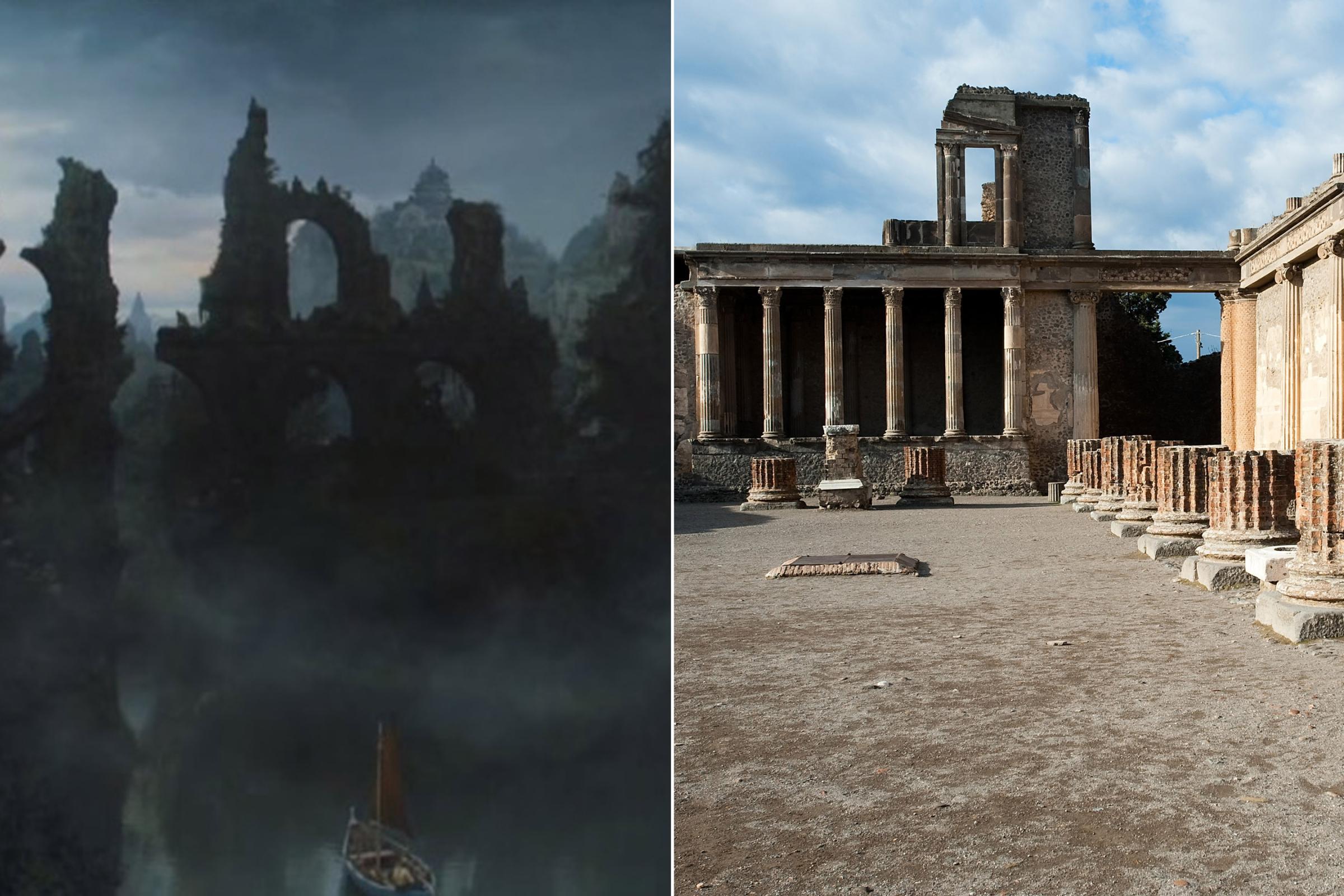Game of Thrones fans may have to make it through winter before another season of the hit HBO show airs, but there’s a new video that puts a different twist on the series.
The same comedians who cut together scenes from Harry Potter showing Harry as the villain are back with a video that does the exact opposite for dangerous boy king Joffrey Baratheon. The clips, which took BloodBlitz Comedy more than 50 hours to edit together, are quite laughable as the evil character is painted in a positive light. There are scenes that depict all of his enemies doting on him — Sansa, Tyrion and even Ned. Margaery Tyrell is the villain in this rewrite, but it doesn’t change the outcome: Joffrey still ends up dead.
Melisandre / Rasputin

If the idea of an ambitious mystic who manipulates a gullible ruler into destroying his kingdom and legacy doesn’t ring a bell, you haven’t read enough Russian history. While much of the source material for Game of Thrones comes from medieval Europe, Martin may not draw exclusively from that era. And Melisandre seems to take after Rasputin, who held great influence over Tsar Nicolas II and his wife, Alexandra, just before the Russian Revolution. Rasputin was a Russian mystic who first gained the confidence of Tsarina Alexandra and then the Tsar himself, thanks to his ability to ease the suffering of their son Alexei, who suffered from hemophilia. Just like Melisandre, Rasputin encouraged the Tsar to lead his armies in battle—in World War I, another wintry hellscape—which proved to have disastrous consequences for the Tsar. Eventually, partly because of the corrosive effect of Rasputin’s influence, the entire family was murdered in the Russian Revolution. One big difference is that Rasputin made the Tsar’s son Alexei feel better, while Melisandre condemned Stannis’ daughter Shireen to death.
Olly / Brutus

Jon Snow’s shocking murder bears a striking resemblance to Julius Caesar’s. Both were stabbed repeatedly, with each knife held by a different colleague. And just as it was for Caesar, Jon receives his final blow from one of the people he trusted most: Olly, the farm boy who watched the Wildlings slaughter his parents. Olly had been Jon’s protege, just as Brutus had been Caesar’s trusted friend (at least in Shakespeare’s retelling of the assassination) but both turned murderous after their mentors assumed too much power. In Jon’s case, it was the unilateral decision to let the Wildlings south of the Wall; in Caesar’s case, it was when he named himself “dictator in perpetuity.” No wonder everyone seems to be tweeting, “Et tu, Olly?”
Fighting Pits / Colosseum

In Mereen, and elsewhere in Slavers’ Bay, slaves fight to the death for cheering audiences and a chance to gain their freedom. In Ancient Rome, slaves and fighters fought as gladiators in the Colosseum for the same reasons. The fighting pits even look like the Colosseum, down to the subterranean chambers where the fighters wait for their turn.
Loras Tyrell / King Edward II of England

Loras Tyrell and King Edward II of England were both handsome, both considered excellent fighters, and both brought down by their scandalous affairs with men. Loras Tyrell was imprisoned by the High Sparrow for his fooling around. King Edward II was widely rumored to be romantically involved with his squire and companion Piers Gaveston, despite his marriage to Isabella of France, who is remembered as a cruel but beautiful queen. (Remember that Loras was betrothed to Cersei, who is nothing if not beautiful and cruel.) Edward II’s romance with Gaveston strained his relationship with the barons he ruled and caused tension in his marriage to Isabella–Gaveston reportedly even wore jewelry that Edward had given her. These factors, along with a series of wars and invasions, probably led to Edward’s abdication in 1327.
Valyria / Pompeii

Remember when Jorah Mormont took Tyrion Lannister through that spooky ghost city full of Stone Men during the kidnapping-slash-road trip? That was Valyria, the capital of the Valyrian Freehold, once the most powerful civilization in the world and ancestral home of the Targaryens and their dragons. Valyria had been destroyed hundreds of years before the story begins, in what looks like it must have been a massive volcanic event. Tyrion recites a poem about that disaster, known as the Valyrian Doom, as they row through the ruins: “They held each other close and turned their backs upon the end / the hills that split asunder and the black that ate the skies / the flames that shot so high and hot that even dragons burned.” It’s impossible to ignore the comparison to Pompeii, an ancient Roman city that was completely destroyed when nearby Mount Vesuvius erupted, killing almost every inhabitant of the city. Even the imagery of citizens who died as they “held each other close” is eerily similar to the bodies found during the excavation of Pompeii. No dragons, though.
Shireen / Iphigenia

O.K., so this one’s not technically history—but you still might learn about it in history class. Stannis Baratheon isn’t the first warrior-king to sacrifice his daughter to win the favor of the gods. In Greek mythology, Agamemnon sacrifices his daughter Iphigenia in order to implore the Gods to change the wind patterns so he can sail for Troy to fight the Trojan War. Both Stannis and Agamemnon are told by prophets (or, in the case of Game of Thrones, it’s Melisandre) that the only way to ensure victory is to sacrifice their daughters, and both Shireen and Iphigenia are unaware of their fates. And in both stories, the daughter’s sacrifice leads to the demise of her mother: in Game of Thrones, Shireen’s mother Selyse hangs herself after witnessing her daughter’s death, in Greek mythology Iphigenia’s mother Clytemnestra murders Agamemnon for killing their daughter, and is then murdered by her own son as revenge.
Cersei / Jane Shore

Cersei’s hideous walk of shame in the Season 5 finale wasn’t completely made up– that kind of public humiliation was a common medieval punishment for women who were found guilty of adultery or other sexual transgressions. But Martin has said that Cersei’s particular penance was inspired by Jane Shore, the mistress of King Edward IV of England who was forced to walk the streets as a harlot after Richard III took power. Richard was likely punishing Shore for conspiring against his rise more than having sex out of wedlock, but he still forced her to walk around in her undergarments, with bare feet, in 1483. In other circumstances, medieval women found having sex with someone who wasn’t their husband were forced to do the walk naked, as Cersei did.
Read more about the link between Cersei and Jane Shore here: The True History Behind Cersei’s Game of Thrones Walk of Shame
More Must-Reads From TIME
- The 100 Most Influential People of 2024
- The Revolution of Yulia Navalnaya
- 6 Compliments That Land Every Time
- What's the Deal With the Bitcoin Halving?
- If You're Dating Right Now , You're Brave: Column
- The AI That Could Heal a Divided Internet
- Fallout Is a Brilliant Model for the Future of Video Game Adaptations
- Want Weekly Recs on What to Watch, Read, and More? Sign Up for Worth Your Time
Contact us at letters@time.com